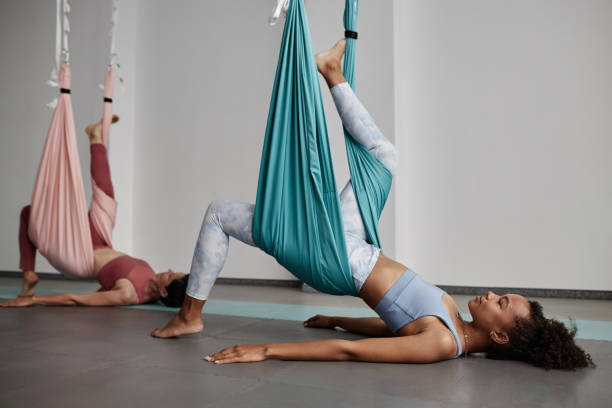
Aerial yoga has recently gained popularity as a fun, challenging, and unique way to build strength, flexibility, and mindfulness. Using a fabric hammock suspended from the ceiling, practitioners perform poses that blend traditional yoga with acrobatics, allowing for deeper stretches, better spinal decompression, and an exciting workout experience.
But while aerial yoga offers many benefits, it’s not for everyone. Some people may find it incredibly beneficial, while others should approach it with caution—or avoid it altogether due to medical concerns. If you’re considering aerial yoga, it’s important to know whether it’s the right fit.
RELATED: 5 Yoga Moves To Start Your Day Off Right
The Best Candidates for Aerial Yoga: Who Benefits the Most?
Aerial yoga isn’t just for circus performers or yogis with years of experience. Many people can benefit from aerial yoga, whether they are beginners or seasoned fitness enthusiasts. Here’s who should consider trying it:
1. People Looking to Improve Flexibility
Traditional yoga is great for increasing flexibility, but aerial yoga allows for deeper stretches due to the hammock’s support. The fabric assists with poses like backbends and hamstring stretches, reducing strain while improving range of motion.
2. Those Who Want Better Spinal Health and Decompression
One of the biggest benefits of aerial yoga is spinal decompression. Hanging upside down in an inversion pose relieves pressure on the spine and can help with back pain. People who sit for long hours, experience mild lower back discomfort, or want to maintain spinal health may find relief through aerial yoga.
3. Fitness Enthusiasts Who Want a Fun, Full-Body Workout
Aerial yoga engages multiple muscle groups at once. The core works overtime to maintain balance, while arms and legs engage for stabilization. Unlike traditional strength training, it builds strength through bodyweight resistance in a dynamic, low-impact way.
4. People Struggling with Balance or Joint Pain
The hammock provides support, allowing individuals to perform yoga poses with less pressure on the joints. This makes aerial yoga a good choice for those recovering from injuries or those who need a low-impact alternative to high-intensity workouts.
5. Those Interested in Stress Relief and Mindfulness
Aerial yoga incorporates elements of meditation, breathwork, and relaxation. The feeling of being weightless can be incredibly calming, making it a great option for those who want to reduce stress and improve mental well-being.
RELATED: 5 Yoga Poses that Strengthen Your Pelvis
Who Should Avoid It? Medical Conditions to Consider
While aerial yoga is safe for many people, it’s not suitable for everyone. Certain medical conditions and physical limitations can make aerial yoga unsafe or uncomfortable. If you have any of the following conditions, consult a doctor before trying aerial yoga—or avoid it altogether.
1. People with Severe Back or Neck Issues
- While aerial yoga can relieve mild back pain, it may be risky for those with herniated discs, spinal instability, or severe scoliosis.
- Hanging upside down (inversions) can put strain on the cervical spine, making it unsafe for those with neck injuries.
2. Anyone with High Blood Pressure or Heart Conditions
- Inverted poses can increase blood pressure and put strain on the cardiovascular system.
- Those with hypertension or heart disease should check with their doctor before attempting aerial yoga.
3. People with Glaucoma or Eye Issues
- Inversions increase pressure in the eyes, which can be dangerous for individuals with glaucoma or retinal conditions.
- The American Academy of Ophthalmology advises against excessive head-down positions for those at risk.
4. Pregnant Individuals
- Aerial yoga involves inversions and movements that may not be safe for pregnancy, especially after the first trimester.
- Some studios offer prenatal aerial yoga modifications, but it’s crucial to get medical clearance first.
5. Those with Severe Motion Sickness or Vertigo
- The swinging motion of aerial yoga can trigger dizziness, nausea, or vertigo, making it uncomfortable for those prone to motion sickness.
- If you experience dizziness in normal yoga classes, aerial yoga may exacerbate the issue.
RELATED: 5 Gentle Yoga Techniques for Joint Pain Relief
Tips for Beginners: What to Expect in Your First Class
If you’ve decided to try aerial yoga, here’s what you should know before stepping into your first class. Being prepared can help you feel more comfortable and confident!
1. Wear the Right Clothing
- Avoid loose clothing that could get tangled in the hammock.
- Leggings and fitted tops work best to prevent fabric burns.
- Remove all jewelry, zippers, or anything that could snag the hammock.
2. Don’t Eat a Heavy Meal Before Class
- Being upside down with a full stomach can lead to nausea.
- A light snack (like fruit or nuts) about an hour before class is ideal.
3. Trust the Hammock, but Move Slowly
- It may feel strange at first, but the hammock is designed to support your weight.
- Avoid sudden movements to prevent swinging too much.
4. Focus on Your Breath and Relax
- Aerial yoga is about mindfulness. Breathe deeply to stay centered.
- Relaxing into poses helps with balance and flexibility.
5. Expect to Feel Sore the Next Day
- Aerial yoga works muscles in new ways, so soreness is normal.
- Stretch and drink plenty of water to reduce post-class stiffness.
Alternative Workouts If Aerial Yoga Isn’t for You
If aerial yoga doesn’t seem like the right fit due to physical limitations, discomfort, or personal preference, don’t worry! There are plenty of alternative workouts that offer similar benefits.
1. Mat-Based Yoga
- Provides flexibility, core strength, and relaxation without the need for a hammock.
- Great for beginners, pregnant individuals, and those with joint pain.
2. Pilates
- Focuses on core strength, stability, and mobility, making it a great alternative for those who can’t do aerial movements.
- Reformer Pilates adds extra support for individuals with back issues.
3. Suspension Training (TRX)
- Uses bodyweight exercises with suspension straps, similar to aerial yoga but with less swinging.
- A good choice for those who want to build strength but avoid inversions.
4. Swimming
- Offers low-impact resistance training that’s easy on the joints.
- Beneficial for those with back pain, arthritis, or heart conditions.
5. Dance-Based Workouts (Barre, Zumba, or Ballet-Inspired Fitness)
- Helps with flexibility, core strength, and balance without the need for aerial equipment.
- Fun and great for stress relief.
Is Aerial Yoga Right for You?
Aerial yoga can be an amazing workout that builds strength, flexibility, and mindfulness, but it’s not suitable for everyone. If you have no major health concerns and love trying new fitness styles, it’s worth giving it a shot!
However, if you have certain medical conditions, discomfort with inversions, or prefer more grounded workouts, consider alternative exercises that offer similar benefits.
No matter what, the key is to find a movement practice that makes you feel strong, healthy, and happy. Would you give aerial yoga a try?









